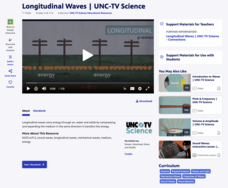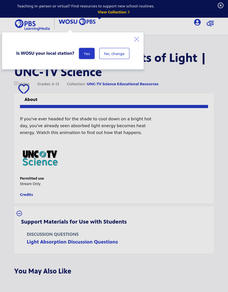Visual Learning Systems
The Nature of Light: Wavelength and Frequency
Students will learn about the different frequencies along the electromagnetic spectrum. Vivid animation is used to explore the visible spectrum of light and the colors it allows us to see everyday. The video also investigates various...
Getty Images
A dispersive equilateral prism refracting and reflecting an incoming beam of uniform white light. Refraction of light results in the light being split into its constituent spectral colors (the colors of the rainbow)
A dispersive equilateral prism refracting and reflecting an incoming beam of uniform white light. Refraction of light results in the light being split into its constituent spectral colors (the colors of the rainbow)
Getty Images
Triangular prism splitting a ray of white light into its constituent colours.
This occurs because the light is refracted when it passes from the air to the glass, as the speed of light in glass is lower than that in air. Light with a shorter wavelength, at the blue end of the spectrum, is refracted more than the...
Getty Images
Triangular prisms splitting rays of white light into constituent colours.
This occurs because the light is refracted when it passes from the air to the glass, as the speed of light in glass is lower than that in air. Light with a shorter wavelength, at the blue end of the spectrum, is refracted more than the...
Curated Video
Using nanomaterials to make solar panels more efficient
AP Television
Boston, Nov. 5, 2010
1. General shots Boston skyline
2. Various solar panels on roof of MIT library
3. Wide shot entrance to MIT Building 66
AP Television
Boston, Nov. 3, 2010
4. Zoom in sign for MIT Institute for Soldier...
Curated Video
Remote desert becomes Mars for NASA scientists
Guanaco Mine, South of Antofogasta in the Atacama Desert - 16 October 2005
1. Various wide shots red, rocky terrain of the Atacama
2. Various team of NASA scientists gathered by vehicles
3. Robot Zoe driving along
4. Cameras on top...
Curated Video
Nasa telescope finds light from new solar planets
1. Various of NASA animation of planets
2. NASA animation of Spitzer Space Telescope
3. SOUNDBITE (English) Dr. Alan Boss, Astronomer, Department of Terrestrial Magnetism, Carnegie Institution of Washington
"1995 was the beginning of the...
Scholastic
Study Jams! Light
Let there be light in your classroom with a video that explains that light travels in waves, the electromagnetic spectrum contains seven colors, and the color of an object depends on which light waves it reflects and absorbs. With...
PBS
Longitudinal Waves | UNC-TV Science
Discover whether sound travels in space and other fascinating science facts. Scientists explore energy transfer by longitudinal waves and learn about compression, rarefaction, amplitude, and wavelength while watching an animated video....
PBS
Light Absorption: Effects of Light | UNC-TV Science
Beat the summer heat by exploring the properties of color. Scientists view a video explaining the relationship between light absorption and energy transfer using variables including intensity, time, and wavelength. A multiple-choice...
PBS
Electromagnetic Waves | UNC-TV Science
These waves aren't for surfing. Young scientists learn about electromagnetic waves and how their features affect the light people see. The video lesson describes the amplitude, frequency, and wavelength of the waves and how the...
PBS
Visible Light | UNC-TV Science
Shine a little light on the topic of visible light with a quick video lesson. The lesson highlights the basics of visible light including wavelength and electromagnetic energy. Learners discover how humans' eyes process the...
TED-Ed
What Makes Neon Signs Glow? A 360° Animation
Why are neon signs so bright and colorful? Scholars discover how artists create neon signs and find out that neon is not the only gas they use in their production. Next, they explore the history of neon signs and how their development...
Veritasium
Can You Recover Sound from Images?
Amazingly, still images can produce sound. Watch as a video lesson describes the process scientists use to recover sound from still photography. The lesson includes discussion of sound waves, vibrations, and frequencies.
Veritasium
How Microwaving Grapes Makes Plasma
Put a pair of grapes in a microwave, sit back, and watch the show! A video lesson shows how microwaves make plasma from the components of the grapes. The narrator interviews experts in the field to explain how the frequency and...
SciShow
How We Accidentally Discovered Gamma-Ray Bursts
Sometimes the best discoveries happen by chance. Scientists did not plan to find gamma-ray bursts, but that doesn't make the revelation less important! A video lesson in the SciShow Space series discusses the discovery of gamma-ray...
Veritasium
Science of Laser Hair Removal in SLOW MOTION
Lasers attack hair cells from the outside in. Young scholars observe a laser hair treatment in slow motion. They watch as the pulses of the laser destroy the external hair. The Veritasium instructor then describes the process happening...
Be Smart
Why Is This Ice Blue?
What gives glaciers their blue hue? Study the phenomenon from the inside out with a video from an engaging science playlist. The narrator describes the conditions present in glacial ice, then explains how the substance affects visible...
Be Smart
Why Is Blue so Rare in Nature?
Why so blue? As it turns out, very few things in nature only reflect blue light! A short video from a comprehensive science playlist highlights the beautiful blues of butterflies, birds, and human eyes. The narrator shows how adaptations...
PBS
The Electromagnetic Spectrum
What can the electromagnetic spectrum tell us about the sun? As it turns out, quite a bit! See the sun in a whole new light with a video from NOVA's Sun Lab unit. The narrator describes the electromagnetic spectrum in terms of visible...












